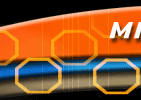




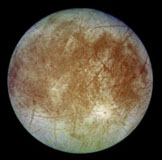
To
understand Europa,
we must first understand its environment - the Jovian system -
for the gas giant and the three other Galilean satellites play a key part
in creating and maintaining the moon's local conditions. First,
we need to think about Io, the closest to Jupiter
of the large moons.

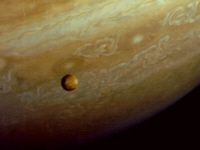
(left) Volcanic
eruption on Io. (right) Io and
Jupiter
Io is volcanically highly active. In fact volcanic activity is happening all the time on Io and the surface is remodeled on a regular basis.
Why, though is Io so active? The answer is tidal forces acting between Jupiter and its moons. As the moons go round Jupiter their gravity pull on one another changes. Io is closest in to Jupiter and orbits fastest, so as it passes the other three outer moons it gets pulled towards them - not enough to change the orbit, but enough to slightly change the shape of the moon itself. Its surface is distorted. Io is kneaded like a ball of clay. What happens if you roll a lump of modeling-clay in your hands? It heats up not only from the warmth of your hands, but also from internal friction, as the clay slides around. Io's experience is similar. The interior is being violently kneaded squeezed. The surface, though, is exposed to the cold of space - around 3 Kelvin (about 5 F above Absolute Zero) or so when out of the direct sunshine - and it gives off heat constantly. The surface is something close to 120 Kelvin (153 C or 211 F below freezing), which is still well below the freezing point of water, which is 273 Kelvin (0 C or 32F). The surface crust radiates heat, solidifies and tries to shrink down, as any cooling solid will, while the interior continues to heat up. The result is that the molten interior bursts through the surface as lava flows and volcanoes.
The same action happens to Europa, but the situation is not as severe, as it is further from Jupiter. The tidal forces are not as extreme. Heating still occurs and this has a rather interesting effect. The moons of Jupiter contain a lot of water, frozen solid as ice. It is so cold it is like rock and can be part of the structure of a moon. But Europa is different.

The structure of Europa - Alternative theories - is there liquid water below the ice, or just slush?
Tidal interaction causes internal heating inside Europa. This is only enough to melt out the ice from the interior, so it can rise to the surface of the denser rocky and metallic core. On the surface it is exposed to the cold temperature of space and it freezes. The surface temperature is around 128 Kelvin (145 C of 200 F below freezing) according to the Galileo spacecraft. When we look at Europa, what we see is a vast and complete ocean of ice. It looks like the Arctic, and it covers the whole moon. The ice at something like 8 to 10 km (5 to 6 miles) thick, scientist believe, though some very recent results from Galileo suggest that in places the depth is as little as 1 km ( 5/8 of a mile). Our current view of Europa is that it has an icy crust with water or slush below, which is perhaps a hundred or more kilometers (over 60 miles) deep. We then reach a silicate mantle and at the center there is a metallic core.
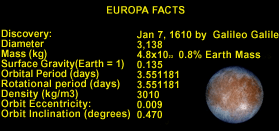
Like
our Moon, Europa rotates at the same rate as it orbits, so the same side
always faces Jupiter. Note also, that it goes round the planet in
just three-and-a-half days. It is approximately the size of Earth's
Moon, but its appearance and composition are very different, as we have
seen. It is smooth and unlike most moons in the Solar System is
nearly craterless. Strange dark lines seem to be etched across the
surface, giving the moon a "cracked eggshell" appearance. Some areas
are slightly yellow in appearance. The Galileo spacecraft found
this to be sulfur dust ejected into space by volcanic eruptions on Io.
It is now thought that vast pools of frozen
sulfuric acid have formed, and some of this may be the strength of
car battery acid. Other patches of color though are more enigmatic,
and appear to have welled up from underneath.
 Ice
flows on Europa and Earth
Ice
flows on Europa and Earth
There
has been much speculation as to whether there is liquid
water under the ice of Europa. The subsurface may be slushy
or liquid. The Galileo spacecraft images show that ice flows have
drifted, thus implying a subsurface that can flow. The visible surface
resembles the frozen seas of the Arctic or Antarctic, which break up from
time to time. Now, while the processes of ice break-up on
Earth are obvious - wind, weather, seasonal temperature variations and
tidal forces - of these only tidal forces are likely to occur on Europa,
and the effects will be much more pronounced than on Earth. The
surface is likely to be distorted by tens of meters, in much the same
way as is seen on Io.
When compared with its sister moons, Ganymede and Callisto, Europa has very few meteorite craters. This suggests the surface of Europa is young - a few millions of years old at most - and implies that the surface ice is recycled. The process by which this occurs is not clear yet, but it could mean that processes akin to ocean floor spreading and subduction occur on Europa, with the ice behaving like the crust of the Earth. On Europa possible areas where spreading takes place can be seen, but areas of subduction have not been located.
Dark colored patches on the surface may indicate the presence of rocky material. This may have come from asteroid impactors or may have been ejected through surface cracks as upwelling liquid mud. From spectral analysis results obtained by the Galileo probe, this appears to be salty in nature - specifically magnesium sulfate, better known as the medication Epsom Salts! It would not account for the coloration, though. This is thought to be silica in some form, though some planetary scientists have speculated that it may be organic in nature.
 The
Pwyll Crater
The
Pwyll Crater
The NASA image shows the Pwyll crater. The impact is thought to be something between 10 and 100 million years old. The false color shows that there is darker material around the crater, and this suggest rock which may have been excavated from deep down. The crater is shallow, however, and the central peaks are high. This implies that the subsurface was sufficiently fluid that it collapsed or filled the hole that would have been formed by the impact.
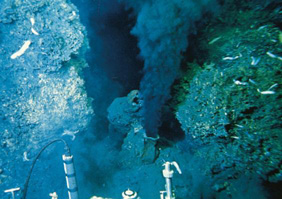 Black
Smokers on the mid-ocean ridges of Earth may also occur on Europa.
As on Earth, does life flourish around the nutrient rich vents that provide
all the energy life needs?
Black
Smokers on the mid-ocean ridges of Earth may also occur on Europa.
As on Earth, does life flourish around the nutrient rich vents that provide
all the energy life needs?
The combination of interior heat, liquid water, and infall of organic material from comets and meteorites, means that Europa has the key ingredients for life. Europa, like Mars and the Saturn moon Titan, is a laboratory for the study of conditions that might have led to the formation of life in the Solar System. At present, though, there is not a shred of evidence for the existence of any form of life on Europa. However, we can say that some of the conditions are right for life; and with a little informed speculation it is possible to say that if life exists anywhere in the Solar System other than Earth then it will exist on, or rather in, Europa.
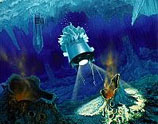
NASA visualizes a Europa mission. Will it find life?Life
needs liquid water, a warm localized environment, hot-spots - say around
273 to 500 Kelvin ( 0 C to 227 C or 32 to 425 F) - from freezing at normal
atmospheric pressure to boiling at high pressure - the right chemicals
and time to get started. It also needs a little stirring around,
a shield from excessive radiation, and a little gravity to allow centrifugal
separation of suspended particulates.Many
informed planetary scientists are certain that Europa supplies some of
these conditions, and we are fairly certain that it could supply the others.
The required warm environment could come from geothermal vents, such as
are found on the mid-ocean ridges of Earth. These black smokers,
as they are called, are rich in essential life nutrients and whole isolated
ecosystems live in the vicinity of such places, from simple bacteria to
fish. The temperature of the smokers can be well above boiling point
(327 C or 620 F) and they can release obnoxious chemicals such as sulfur.
But primitive life still flourishes, and flourishes well.
NASA is planning several Europa missions including a lander with a drilling device and a submarine explorer. These will attempt to uncover some more of its secrets.
Europa
missions
Europa Orbiter
Europa
Ice Clipper
Europa
Ocean Observer
Europa
Lander
Divining Water on Europa
Sulfuric Acid Found on Europa
Galileo buzzes Europa
Happy New Year, Europa
BBC News | SCI/TECH | How life may live on Europa
Jovian Radiation Could Heat Up Europan Life
Galileo Images of Europa
Galileo Findings Boost Idea of Other-Worldly Ocean
Spacecraft finds alien ocean
Surf's Up on Europa?
Galileo Provides Further Evidence of an Ocean on Europa
© All images NASA
Go
to
Home
| Space Station
| Mars | Rainforest
© 1999 Satellite Events Enterprises Inc.